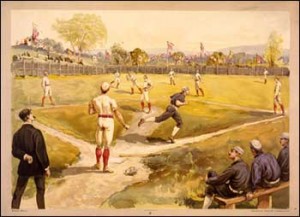 In sports law, the concept of “competitive balance” has played an important role as a justification for practices that would otherwise run afoul of the antitrust laws and the common law of unfair competition. The conventional logic has it that unless teams in an individual sports league are reasonably competitive, fans of the weaker teams will lose interest, which will cause those teams to fold, which will in turn threaten the survivorship of the league itself. Consequently, restraints on player mobility, like the amateur player drafts, salary caps, and reserve clauses, and territorial restrictions on franchise location and broadcast rights have been justified in the past (at least by their advocates) as necessary to maintain “competitive balance” in sports leagues.
In sports law, the concept of “competitive balance” has played an important role as a justification for practices that would otherwise run afoul of the antitrust laws and the common law of unfair competition. The conventional logic has it that unless teams in an individual sports league are reasonably competitive, fans of the weaker teams will lose interest, which will cause those teams to fold, which will in turn threaten the survivorship of the league itself. Consequently, restraints on player mobility, like the amateur player drafts, salary caps, and reserve clauses, and territorial restrictions on franchise location and broadcast rights have been justified in the past (at least by their advocates) as necessary to maintain “competitive balance” in sports leagues.
Exactly what constitutes “competitive balance” and whether or not it has existed at particular times has been a matter of some controversy. Should competitive balance be measured by the closeness of competition during an individual season, or should it be measured by the frequency with which different teams win championships? Does competitive balance mean the same thing with regard to each sport?
Although the National Football League is often lauded for its competitive balance, within any given NFL season there is always great disparity between the winning percentages of the most and least successful teams. For example, during the 2009 season, the Indianapolis Colts, the team with the best record (14-2) won 87.5% of its games while the St. Louis Rams, the team with the worst record (1-15) won only 6.3% of its games. Overall, the Colts winning percentage exceeded that of the Rams by .812.
In contrast, in Major League Baseball in 2009, the winning percentage of the most successful team in the regular season, the New York Yankees, exceeded that of the worst team, the Washington Nationals, by only .272 (.636 to .364). The 2009 gap in baseball was actually somewhat higher than usual; in 2000, admittedly a very balanced year, the gap between the best team, the San Francisco Giants, and the worst teams, the Chicago Cubs and Philadelphia Phillies, was only .196 (.597-.401).
The disparity between baseball and football is often attributed to the very short (in terms of number of games) NFL season. While this may be part of the explanation, it is not the whole answer. If one aggregates individual team records for the past ten NFL seasons (160 regular season games), the best team, the New England Patriots compiled a record of 112-48, for a winning percentage of .700, a mark exceeded in a single season by only three major league baseball teams over the past 70 years. The worst team, the Detroit Lions, has a combined record of 42-188, for a winning percentage of only .262, a mark exceeded by only one baseball team (the 1962 New York Mets) since 1935.
Basketball season records also show much greater variation between the best and worst teams than is found in baseball. If the NBA’s current best (Cleveland Cavaliers) and worst (New Jersey Nets) teams finish the season with their current winning percentages, they will have accomplished the equivalent of a major league baseball team finishing its season with a record of 126-36 and 16-146, respectively. In the 134 year history of major league baseball, no team has ever done that well, or that poorly. In the NHL, the performance range is more narrow, but still much broader than in Major League Baseball.
The following text, which I originally submitted to the Listserv of the Society of American Baseball Research, explores the status of the competitive balance questions in 1960, which was just before the modern explosion of the number of major league sports teams in the United States and Canada. In 1960, there were a total of only 42 teams in Major League Baseball, the NFL, the NBA, and the NHL. By 2004, that number had grown to 122.
Now that we are almost 50 years removed from the expansion of major league baseball that occurred in 1961, it makes more and more sense to use 1960/1961 as a dividing point in the “periodization” of baseball history. Although relatively little changed in 1961 itself, it ushered in an era of significant changes in the way in which major league baseball was organized and, with the adoption of the designated hitter rule and the construction of multi-purpose stadiums, played.
This leaves us with three basic divisions—the Formative Era (1871-1900), the Golden Age (1901-1960), and the Modern Era (1961-present). I will acknowledge that this choice of terminology has “Baby Boomer” written all over it.
At the end of the Golden Age, Major League baseball had achieved a measure of competitive balance missing in the highest leagues of other major sports. The simplest measure of competitive balance is the index of how frequently lower performing teams defeat their higher performing counterparts. If we rank the major league baseball teams of 1960 in regard to their final regular season records, we find that in almost 42% of games, the team that would finish lower in the standings at the end of the year nevertheless won the game. In 1960, the lower ranked team came out victorious in 515 of 1232 games, for a winning percentage of .418 The NL was slightly more competitive than the AL, with its lower ranked teams having a winning percentage of .429, compared to .407 in the AL.
In the other sports, the teams that finished higher in the standings won much more frequently. In the NHL season of 1959-60, higher ranked teams finished 113-61-36 in games with lower ranked opponents, which translates into a .376 winning percentage for the lower ranked teams (using the NHL’s system of counting a tie as the equivalent of one-half of a win). In the NBA, the overall record of higher ranked teams was 211-89, which meant that the lower ranked teams won only 29.7% of the time. The greatest disparity was in the NFL (in which teams played only 12 regular season games). Not counting two games between teams that ended the season with identical records, the higher ranked NFL teams finished the season, 57-14-5, which translated to a .803 winning percentage by the method used at the time and to .783 by the current standards. Either way, lower ranked teams won only about 20% of the time.
There were, of course, major league teams in 1960 that baseball fans considered “terrible,” particularly the Philadelphia Phillies (59-95) and the Kansas City Athletics (58-96), the last place finishers in their respective leagues. However, the last place teams in the other leagues did much worse in 1960. In the NFL, the Dallas Cowboys were 0-11-1, and the Washington Redskins 1-9-2 (defeating only the Cowboys). The worst team in the NBA, the Cincinnati Royals, finished 19-56, which was the equivalent of 41-112 in baseball, while the last place finisher in the six-team NHL was the New York Rangers, whose record of 17-38-15 translates to 54-100 in 1960 baseball terms.
I am not arguing that this level of balance was a feature of major league baseball that developed only at the end of the Golden Age. It may well have been the pattern throughout the history of major league baseball. It is also my impression that the disparity between baseball and other major league team sports that can be seen in 1960 has continued into the modern age. However, I am suggesting that the factors that have led to greater competitive balance in baseball than in other sports do pre-date the modern era.
 Next week marks both the opening day of the baseball season in Milwaukee and the finals of the Jenkins Moot Court competition. Few recognize the historical connection between these two events.
Next week marks both the opening day of the baseball season in Milwaukee and the finals of the Jenkins Moot Court competition. Few recognize the historical connection between these two events.

